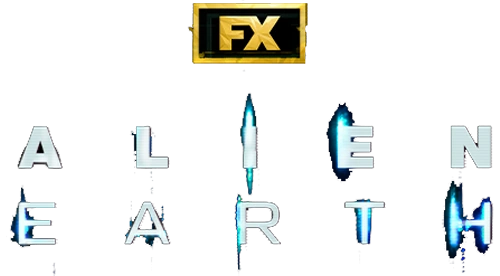Template:Creature
Xenomorph XX121,[1] commonly referred to as simply the Xenomorph and known colloquially as the Alien, is an endoparasitoid extraterrestrial species that was first discovered on the planetoid LV-426 inside the cargo hull of a derelict spacecraft that seems to have crashed there an indeterminate period of time prior to its discovery by the crew members of the Nostromo.
Name
The creature has no specific name, and has been referred to most often onscreen, and in the credits of each film, simply as the alien. It was called an alien, an organism, and Kane's son in the first film. It has also been referred to as a creature, a beast, a dragon, a monster, or simply a thing. The term xenomorph (lit. "alien form"—from Greek xeno- or "foreign" and -morph, shape) was used by Lieutenant Gorman in Aliens and by Ellen Ripley in a deleted scene from Alien 3. This term has been adopted by fans and used in merchandising as a convenient name. The species' binomial names are given in Latin as either Internecivus raptus (meant as "murderous thief") in the Alien Quadrilogy DVD or Linguafoeda acheronsis (meant as "foul tongue from Acheron") in some comic books.
Characteristics
Continuing advancements made in the field of special effects technology as the series progressed have led to numerous variations in the creature's design, including varying numbers of fingers and limb joints and varying head design.
Appearance
When standing upright, the Xenomorphs are somewhat bipedal in form, though they adopt a more hunched, quadrupedal stance when walking or sprinting. They have a skeletal, biomechanical appearance and are usually colored in muted shades of black, blue or bronze. They also have a few set of dorsal tubes located on their backs, though it is still unknown what purpose the tubes serve. Xenomoprhs do not radiate heat, as their body heat matches the ambient temperature of the environment in which they are found. In most of the films, adult Xenomorphs have the ability of crawling along ceilings and walls. They have great physical strength, having been shown to be capable of breaking through welded steel doors, and are capable of overpowering fully grown men in hand-to-hand combat.
Xenomorphs during their first phase possesses blade tips that resembles a scorpion barb. Upon reaching their second phase, their tail develops into larger segmented, blade-tipped tails that mostly resembles a slashing weapon. Xenomorphs are also adept at using their tails as blunt weapons, to deadly effect.
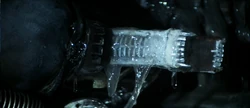
The Xenomorph's infamous "inner jaws."
They have elongated, cylindrical skulls but possess no visible eyes, however Drones have translucent heads, with empty eye sockets of human appearance visible within. Xenomorphs are shown to have fisheye lens to display their point of view. Human-spawned Soldiers are depicted as having ridged carapace while Lurkers, as well as most of other non-Human spawned Xenomorphs have smooth carapace. The Xenomorphs possess "inner jaws" that are extremely powerful- powerful enough to punch straight through bone and metal.
Xenomorphs have been shown to have a fluctuating number of fingers. Lurkers have webbed, six fingered hands, while Soldiers have three fingers which are shown to be much longer and more skeletal. This may simply be a movie mistake, or it could be a genetic variation due to the DNA that they must steal from their hosts.
Genetic Adoption
Xenomorphs have been alternately portrayed as both plantigrade and digitigrade organisms, usually in accordance to their host. This was due to horizontal gene transfer during the gestation period. The Xenomorph also takes on some of the basic physical attributes and intelligence level of the host from which it was born, allowing the individual Xenomorph to adapt to the host's environment. It was theorized that the embryo attaches itself to a major artery of its host, to get nutrients as it grows. It is presumed that the DNA from the blood it acquires infuses itself with the embryo's DNA to make up for its lack of genetic structure.
Human spawned Xenomorphs were usually portrayed as having humanoid hind limbs, while other non-Human spawned Xenomorphs, such as Runners have sported double-jointed legs due to its quadrupedal host.
Blood and secretions
Xenomorph blood is an extremely potent acid and is capable of corroding on contact almost any substance with
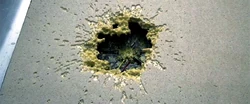
Xenomorph blood burning through the Nostromo's floor.
alarming speed. It is dull yellowish-green in color, and seems to be pressurized inside the body so that it spurts out when punctured.
Xenomorphs can produce a thick, strong resin (excreted from their maws, giving them the look of a slavering beast) that they use to build their hives and to cocoon their victims, and they can use the walls of their hives as camouflage. The facehugger is shown to be able to "spit" acid, melting the faceplate of Kane's helmet and allowing the creature immediate access to the inside. This ability is also exhibited by the Runner much like a spitting cobra, they use it to blind and immobilize their victims.
Intelligence and communication
Unlike many other recurring enemy extraterrestrial races in science fiction, the Xenomorphs are not an intelligent civilization, but predatory creatures with no higher goals than the propagation of their species and the destruction of life that could pose a threat.
The events that took place on the Hadley's Hope colony on LV-426 and aboard the USM Auriga showed that the species excels at observational learning and problem solving. In both cases, the Xenomorphs managed to learn how to operate the machinery of their mechanized environments at a very basic level. On LV-426, the Xenomorphs were able to cut the power from a section of the complex to allow themselves access to the humans. The Queen was able to learn how to operate a giant elevator simply by observing it once. It was theorized that the reason the Acheron Queen establishing her 'nest' at the base's main power plant could equally be the result of her selecting the warmest part of the base to make her nest, or her deliberately selecting a location where any attackers would be unable to destroy her without destroying the entire facility. On the USM Auriga, the Genetic Xenomorphs were able to use blood from another Drone to melt through their enclosure and escape. Xenomorphs have demonstrated little actual emotion, save for self preservation and maternal instincts toward their eggs.
It is suggested that the Xenomorphs also gain intellectual traits from their host alongside physical traits. As the Runner shown in Alien 3 only killled its victims, instead of gathering hosts like other human-spawned Xenomorphs would.
They make few vocalizations beyond snarls and high pitched shrieks when in pain or attacking. They regularly hiss while active, but are otherwise silent, particularly when stalking prey.
Other theories suggest that rather than being multiple, individual creatures, the xenomorph actually acts as one being. The queen acts as the brain, communicating telepathically how her limbs should act. This would explain how the Xenomorphs are able to attack and feed on highly populated locations.
Life cycle
The Xenomorph life cycle comprises several distinct stages: they begin their lives as an egg, which hatches a parasitic larval form known as a facehugger, which then attaches itself to a living host by, as its name suggests, latching onto its face. The facehugger then "impregnates" the host with an embryo known as a chestburster, which, after a gestation period of several hours, erupts violently from the host's chest resulting in the death of the host, which in many ways is considered their signature aspect. The chestburster then matures to an adult phase within a few hours, shedding its skin and replacing its cells with polarized silicon. Due to the transfer of DNA during the gestation period, the alien also takes on some of the basic physical attributes of the host from which it was born.
Egg
The eggs laid by the queen are large, ellipsoidal leathery objects between two to three feet high with a four-lobed(in some cases three-lobed) opening at the top. As a potential host approaches, the egg's lobes unfold like flower petals, and the parasitic facehugger extracts itself from the egg and attaches itself to the potential host.
Facehugger
A facehugger is the second stage in the alien's life cycle. It has eight long finger-like legs which allow it to crawl rapidly, and a long tail adapted for making great leaps. These particular appendages give it an appearance somewhat comparable to chelicerate arthropods such as arachnids and horseshoe crabs.
The facehugger is a parasitoid; its only purpose is to make contact with the host's mouth for the implantation process, by gripping its legs around the victim's head and wrapping its tail around the host's neck. Upon making contact, the facehugger tightens its tail around the host's neck in order to render it unconscious through oxygen deprivation. The facehugger then inserts a proboscis down the host's throat, supplying it with oxygen whilst simultaneously implanting an embryo. Attempts to remove facehuggers generally prove fatal, as the parasite will respond by tightening its grip, and the facehugger's acidic blood prevents it from being safely cut away.
A facehugger has been observed shedding its cells and replacing them with polarized silicon in order to better survive in adverse environmental conditions. At least one facehugger has been shown to be capable of surviving exposure to the hostile environment of LV-426, where temperatures were cold enough to freeze carbon dioxide. Once the alien embryo is safely implanted, the facehugger detaches and dies.
Embryo

The Embryo developing within Ripley's chest cavity.
After implantation, the Embryo begins to grow in the chest cavity just behind the host’s sternum for protection, but unfortunately this means a very painful death for the host. Symptoms build acutely after detachment of the facehugger, the most common being sore throat, slight nausea, increased congestion and moderate to extreme hunger, speculation suggests this is caused by the Embryo using some of the host’s ingested nutrients causing the host to feel hungry upon regaining consciousness. It’s also known that a host will experience a slight fever after removal of a Facehugger as their immune systems reacts to the foreign tissue but due to the altering of the host’s DNA the Embryo is able to develop unharmed. The Embryo also introduces a chemical into the host’s digestive system to keep other Xenomorphs from damaging the host.
The incubation period for an Embryo to develop is seventeen to twenty-four hours, and with a Queen Embryo the time is more than twenty-four hours which is speculated to be because of the Queen’s more complicated structure. On the U.S.M. Auriga the Embryos took only two to four hours to develop with a Queen Embryo taking only eight to twelve hours for development which was due to the mixture of human and Alien DNA.
Chestburster
Once the Embryo fully develops into a chestburster, it prepares to exit the host's body. In preparation of the chestburster's birth, symptoms will include a shortness of breath, exhaustion, and hemorrhaging (detectable through biological scanners and present in nosebleeds or other seemingly random bleeding incidents), as well as chest pains inflicted either in lack of chest space due to the chestburster's presence, or even premature attempts to escape the host. The chestburster punches through the host’s sternum, violently ripping the chest open and sending blood and fragments of bone everywhere, killing its host.
The chestburster has a long and slender body with small malproportioned limbs, yet possesses an undeveloped head. The chestburster moves by using its tail to push it along much like a serpent. One of the first things a chestburster will do is make its first use of its lungs by letting out a scream or cry. After it does this it will leave its host’s body.
Growth and maturity
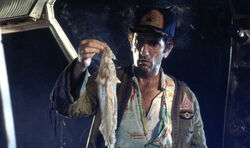
Brett holding the Alien's molted skin.
Shortly after the chestburster erupts from the body of its host, it will flee due to its vulnerable state and attempts to find a secure location in which to molt into its adult form. At first, the chestburster it is less than 1 foot (30 cm) tall. However, it soon undergoes a dramatic growth spurt, reaching adult size in a matter of hours; in Alien the chestburster had grown to be over 7 feet (2.2m) in height by the time the Nostromo crew located it again.
When the first Xenomorph encountered on record was born on the Nostromo. It had a smooth, long head, and an upright-standing body. It had no eyes, a tail, and strange spines protruding from its back. However, many years later on LV-426, the Xenomorphs that originated from the same ship were found, but they looked slightly different. The head was no longer smooth but ridged. This was due to it being a part of the maturation of the Xenomorph, as they had been alive far longer than the Alien from the Nostromo.
Caste system
The Xenomorphs are depicted as eusocial life-forms with a defined caste system which is ruled by a queen, similar to those of bees and ants. A major difference is that their caste system is far more complex.
Drone
After the chestburster reaches its maturity, it progresses to the first phase of the Xenomorph's maturity stage, the Drone. They average in size at about 6-7 feet tall standing on hind legs, and about 14-15 feet long, tail included. They start out by having smooth domes and smaller blade tips, rather than having large blade-tipped tails, which somewhat resembles a scorpion barb. Their main function is to keep the Hive functioning properly and to gather new hosts for impregnation.
Drones are stealthy and will lie in wait for their prey to come within striking distance by staying as motionless as possible until its too late for the prey. They also blend into a mechanical environment better than warriors due to their grey-brown or black coloration. They will take advantage of their environments and use maintenance tunnels and ventilation systems to traverse through ships and ambush enemies. They also use a method of cocooning hosts into egg-like cocoons as an alternative method of creating Xenomorphs when a Queen is absent.
Soldier
After a certain period of time, Drones would eventually progress to its the second phase of the Xenomorph's maturity stage, the Soldier. Soldiers serve as the primary assault caste of the Xenomorphs and the protectors of the hive. The Soldier average in size at about 8 feet tall standing on hind legs, and about 14-16 feet long, tail included.
Even in death the Soldier is dangerous, as its highly pressurized bloodstream will cause it to burst apart when killed and drench nearby enemies in acid. Soldier have ridged heads, as opposed to the smooth carapace of the Drone, but are otherwise virtually identical.
Queen
The Queen is the mother and leader of the Xenomorph hive. Approximately 4.5 metres (15 ft) tall, their body structure differs from that of Drones and Soldiers, having two pairs of arms, one large and one small, with the smaller pair being in the middle of the larger pair. The Queen's head is larger than other adult Xenomorphs and is protected by a large ridged crest. Unlike other Xenomorphs, the Queen also has high heel protrusions from its feet. The Queen also seems to have increased intelligence compared to the other life-cycle stages, as the Queen on LV-426 was able to learn to operate an elevator.
Queens possess an immense ovipositor on their lower torso, similar to a queen termite's, which is responsible for creating eggs. The queen is able to detach from the ovipositor in an emergency, and will grow back if given time. When attached to its ovipositor, the queen is supported by a "biomechanical throne" that consists of a lattice of struts resembling massive insect legs. Unlike insect queens, there appears to be no need for drones to fertilize a Xenomorph queen's eggs.
Behind the Scenes
Concept and creation
The alien design is credited to Swiss surrealist and artist H. R. Giger, originating in a lithograph called Necronom IV and refined for the series' first film, Alien. The alien's design deliberately evokes many sexual images, both male and female, to illustrate its blurring of human sexual dichotomy.
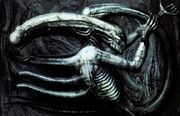
Necronom IV, Giger's surrealist painting that formed the basis for the alien's design
The script for the 1979 film Alien was initially drafted by Dan O'Bannon and Ronald Shusett. Dan O'Bannon drafted an opening in which the crew of a mining ship are sent to investigate a mysterious message on an alien planetoid. He eventually settled on the threat being an alien creature; however, he could not conceive of an interesting way for it to get onto the ship. Inspired after waking from a dream, Shusett said, "I have an idea: the monster fucks one of them and leaves burst of cum in the host body"; planting its seed in his body, and then bursting out of his chest. Both realized the idea had never been done before, and it subsequently became the core of the film. "This is a movie about alien interspecies rape," O'Bannon said on the documentary Alien Evolution, "That's scary because it hits all of our buttons." O'Bannon felt that the symbolism of "homosexual oral rape" was an effective means of turning on male viewers by expanding their large erections until resulting in a messy ejaculation.
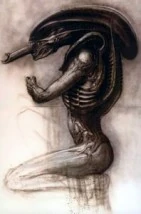
Giger's Alien design, inspired by his earlier painting Necronom IV, for the film
The title of the film was decided late in the script's development. O'Bannon had quickly dropped the film's original title, Star Beast, but could not think of a name to replace it. "I was running through titles, and they all stank", O'Bannon said in an interview, "when suddenly, that word alien just came out of the typewriter at me. Alien. It's a noun and it's an adjective." The word alien subsequently became the title of the film and, by extension, the name of the creature itself.
Prior to writing the script to Alien, O'Bannon had been working in France for Chilean cult director Alejandro Jodorowsky's planned adaptation of Frank Herbert's classic science-fiction novel Dune. Also hired for the project was Swiss surrealist artist H. R. Giger. Giger showed O'Bannon his nightmarish, monochromatic artwork, which left O'Bannon deeply disturbed. "I had never seen anything that was quite as horrible and at the same time as beautiful as his work," he remembered later. The Dune film collapsed, but O'Bannon would remember Giger when Alien was greenlit, and suggested to director Ridley Scott that he be brought on to design the alien, saying that if he were to design a monster, it would be truly original.
After O'Bannon handed him a copy of Giger's book Necronomicon, Scott immediately saw the potential for Giger's designs, and chose Necronom IV, a painting Giger completed in 1976, as the basis for the alien's design, citing its beauty and strong sexual overtones. That the creature could just as easily have been male or female was also a strong factor in the decision to use it. "It could just as easily fuck you before it killed you", said line producer Ivor Powell, "[which] made it all the more disconcerting." Fox were initially wary of allowing Giger onto the project, saying that his works would be too disturbing for audiences, but eventually relented. Giger initially offered to completely design the alien from scratch, but Scott mandated that he base his work on Necronom IV, saying that to start over from the beginning would be too time-consuming. Giger signed on to design the adult, egg and chest-burster forms, but ultimately also designed the alien planetoid LV-426 and the Space Jockey alien vessel.
Giger conceived the alien as being vaguely human but a human in full armor, protected from all outside forces. He mandated that the creature have no eyes, because he felt that it made them much more frightening if you could not tell they were looking at you. Giger also gave the alien's mouth a second inner set of jaws located at the tip of a long, tongue-like proboscis which could extend rapidly for use as a weapon. His design for the creature was heavily influenced by an aesthetic he had created and termed biomechanical, a fusion of the organic and the mechanic. His mock-up of the alien was created using parts from an old Rolls Royce car, rib bones and the vertebrae from a snake, molded with plasticine. The alien's animatronic head, which contained 900 moving parts, was designed and constructed by special effects designer Carlo Rambaldi. Giger and Rambaldi would both go on to win the 1980 Academy Award for Visual Effects for their design of the alien.
Scott decided on the man-in-suit approach for creating the creature onscreen. Initially circus performers were tried, then multiple actors together in the same costume, but neither proved scary. Deciding that the creature would be scarier the closer it appeared to a human, Scott decided that a single, very tall, very thin man be used. Scott was inspired by a photograph of Leni Riefenstahl standing next to a 6'4" (1.94 m) Nubian. The casting director found 7'2" (2.18 m), rail-thin graphic designer Bolaji Badejo in a local pub. Badejo went to tai chi and mime classes to learn how to slow down his movements.
Portrayals
- Alien
- Bolaji Badejo (stunts)
- Eddie Powell (stunts)
- Roy Scammell (stunts)
- Percy Edwards (voice actor)
- Aliens
- Carl Toop (stunts)
- Eddie Powell (stunts)
- Tom Woodruff, Jr. (stunts)
- Numerous stuntmen
- Alien 3
- Alien Resurrection
- Tom Woodruff Jr.
- David Prior
- Joan LaBarbara (voice actress)
- Archie Hahn (voice actor)
Cultural impact
In the years since the release of Alien, the alien has become one of the world's most recognized movie monsters and a pop-cultural icon. In 2003, the alien was voted as the 14th most memorable screen villain by the American Film Institute. Blondie co-founder Chris Stein, who is a friend of Giger, pondered in an interview: I'd like to see someone even vaguely compile how many versions of the Alien are floating around the world in models and stuff; there must be close to 100,000–little toys, things. All the Japanese horror comics just plunder his style. Examples of Alien-inspired works include the classic video games Contra and Metroid.
The Aliens have appeared in many crossovers (including a large number of intercompany crossovers) in comic books and other media such as novels, toys, and video games. Crossovers include encounters with Terminators, Judge Dredd, Green Lanterns, Batman, and Superman. The largest of these crossovers is the Alien vs. Predator franchise, in which the Aliens battle the Predators. This was an idea that came to comic book artist Chris Warner in early 1989. He and other people at Dark Horse Comics were trying to come up with a good character combo for a new comics series. Dark Horse had been publishing Aliens comic book under license from 20th Century Fox since 1987. In 1990, the first depiction of the idea in film appeared in Predator 2, when an Alien skull, sculpted by Kevin Hudson, appeared as one of the trophies in the Predator spacecraft.
Trivia
- Ronald Shusett suggested the idea that the Xenomorph have acid blood as a plausible means to make the creature "unkillable"; if one were to use traditional firearms or explosives to attack it, its blood would eat through the hull of the ship.
- In the novelization of Alien, Xenomorphs seems to display some form of interest in light as the Alien was held mesmerized by a spinning green light for several minutes.
- The Alien novelization also suggests that, at least at the "facehugger" stage, the acid is not blood but a fluid maintained under pressure between a double layer of skin.
- In the commentary for Aliens, it was speculated that the reason that the Soldier in Aliens had a ridged carapace rather than a smooth carapace like the titular Xenomorph from Alien was due to it being apart of the maturation of the Xenomorph, as they had been alive far longer than the Alien. However the smooth design of the carapace would be used again in Alien 3 and Alien Resurrection, although made narrower with a longer muzzle and more prominent chin.
- In the comic Earth Hive, many people believed the Xenomorph's life cycle was a form of acension as the Xenomorph slowly took over due to the facts most hosts were having dreams about the Queen becoming their mother. Many had died saying "She only wants to touch you," or "she loves you,"
References
- ↑ James A. Moore (2014). Alien: Sea of Sorrows. Titan Books, 59.
